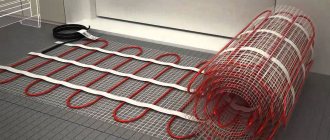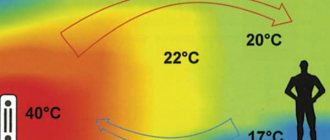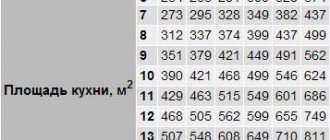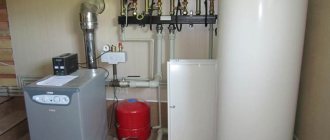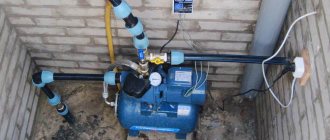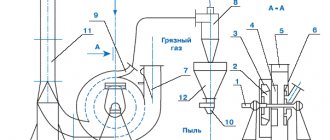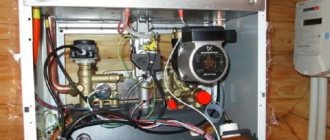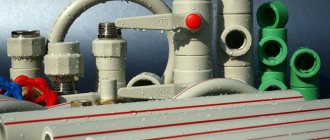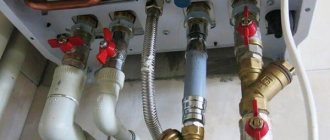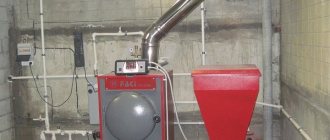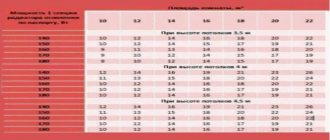When choosing a solid fuel boiler, you need to consider power. It determines whether the device can create the required amount of heat for the entire house or not. It is undesirable to choose a boiler that is too powerful, because it will operate in economy mode, and this will affect the reduction in efficiency.
To make the right choice of a solid fuel boiler, you need to know two indicators:
- The amount of heat required to heat the room and heat the water.
- The real power of the device.
Calculation of power depending on the volume of the room
The calculation formula is:
Q = VxΔTxK/850,
- where Q is the amount of heat , defined in kW/h4;
- V – volume of the room (unit of measurement cubic m);
- ΔT is the difference between the outside temperature and the indoor temperature;
- K – correction factor taking into account heat loss;
- the figure 850 is used to convert the product of the above three indicators into kW/hour .
K can have the following meanings:
- 3-4 – for premises that are a simplified wooden structure or a building made of corrugated sheets.
- 2-2,9 – for buildings with little thermal insulation. The design of such houses is simplified, the wall thickness is equal to the length of 1 brick, the windows and roof have a simple structure.
- 1-1,9 – for houses whose design is standard. The brickwork is double, the number of simple windows is small. The roof has a conventional roof.
- 0,6-0,9 – for houses with improved construction, double thermal insulation of brick walls, double glazed windows, thick floor base, roof made of good thermal insulation material.
As an example, let's take a modern house with an area of 200 square meters. m, wall height 3 m and first-class thermal insulation. The house is located in an area where in winter the temperature does not drop below -25 °C. In this case, ΔT = 20 – (-25) = 45 °C. Therefore, to heat a house you need to create Q = 200*3*45*0.9/850 = 28.58 kW/h. The figure should not be rounded, because it is not final and you need to increase it with your own hands by the amount of heat for the hot water supply. If the water is planned to be heated in a different way, then the result obtained is not adjusted, and part of the calculation is completed.
Calculation methods
To correctly calculate the power of a boiler for heating a private home, you must first write down the parameters of your home and region of residence.
Based on the type of fuel, boilers are divided into:
- gas;
- electrical;
- solid fuel.
The easiest way to calculate boiler power
If you don’t go into details and be sure that during the winter months you will not be left without heat in your house, just add +50% . It is better for your boiler to operate at half its capacity than to constantly be “at the limit” of its capabilities.
In a simple calculation, measure the square footage of the house and multiply by a factor of 0.15 .
For example:
You have a one-story house with an area of 110 m2.
In order to correctly determine the boiler power, you just need to multiply this figure by 0.15.
We get: 110x0.15=16.5
We find that for a house with an area of 110 m2, a boiler with a power of 16.5 kW is needed.
If simple methods are foreign to you and you want to get a little more involved, you need to move on to the next part of our article!
The second way to calculate boiler power for a private house
It is a little more complex than the first one, since many more factors are taken into account, but it is also more accurate. In addition, you will not overpay for an overly powerful boiler, which, as it turns out, you do not need.
An accurate computer calculation of heat loss can be carried out by a specialist designer when drawing up a house project.
An ideal option when calculations are made at the house design stage
If such calculations were not made for the project, then they can be performed independently, if this concerns a private house with a small area. In this case, you will have to answer some questions:
- what material are the walls made of and what thickness are they;
- what is the total volume of cubic capacity of the house;
- the presence of insulation and its thickness;
- the number of windows, their sizes, the materials from which they are made (if these are double-glazed windows, then the number of cameras in them).
These questions are presented in a special questionnaire, which can be found on the Internet on specialized sites. It contains several answers to each question posed, depending on the choice of which the power of the heating device for a particular house will be calculated.
An approximately established coefficient that determines heat loss for the central Russian regions looks like this:
- for a building that does not have thermal insulation - 130-200 W/m²;
- for a house from the 80s-90s with thermal insulation - 85-115 W/m²;
- for construction at the beginning of the 21st century, with double-glazed windows installed - 55-75 W/m².
This coefficient is multiplied by the area of the entire building and the number of heat losses is obtained. However, it cannot be said that based on these figures it is possible to obtain accurate results, since they are produced without taking into account the region where the home is located, the number and size of window openings and other factors on which heat loss directly depends.
Approximate indicators of heat loss in the Central region
Another way to calculate the power of a heating device is to calculate the specific heating power of each room , which are summed up, and the desired value is obtained. This is done using a formula in which the parameters are designated by the following letters and numbers:
- boiler power - W;
- heating power per unit area in sq. meters - W1;
- the area of all heated rooms is ΣS.
The formula itself looks like this: W=ΣSxW1. To apply it in practice, you need to know the power required to heat one m².
It is also determined based on some factors:
- average temperature in a given area during the cold season;
- location of the room (internal or end room);
- number and size of windows;
- expected number of heat sources;
- resistance to heat transfer.
This calculation is quite complicated, so it is better if it is carried out by specialists. But you need to think about whether this is worth doing when the necessary indicators that take into account the climate of the region have already been included in the design of any structure.
Therefore, you can act using a simplified method for determining the power of a heating device.
- The simplest scoring method does not evaluate each individual factor and room, but rather makes a comprehensive assessment of the house. For this, a very simple formula has been developed: 10 m2 = 1 kW with a ceiling height of 2.6 to 3.1 m. That is, for every 10 sq. meters of area, a power of 1 kW is required if the ceiling height is not higher than 3-3.1 m.
For example, a house with an area of 250 sq. meters will require a boiler with a power of at least 25 kW (250: 10 = 25) for high-quality heating
For each region, the value of the power factor is calculated, which takes into account the climate at the location of the home. The product of it and the area of the house will also be a figure that indicates the power of the boiler.
If you get a power value of a rating with which boilers are not produced, then you need to purchase a heating device that will be closest to the calculated value; it is better if the boiler power exceeds the required one .
When using this calculation method, you need to know that it is convenient in its simplicity, but does not give an accurate result for buildings with complex architecture. Therefore, if you need to make calculations for such buildings, it would be better to entrust this work to specialists.
Calculation of heat for hot water supply
To calculate how much heat needs to be spent on heating water, you need to use the formula Qв = с*m*Δt:
- where c is the specific heat capacity of water (the indicator is always equal to 4200 J/kg*K);
- m – mass of water in kg;
- Δt is the temperature difference between the heated water and that coming from the water supply .
Calculation by area
It is more accurate because it takes into account more factors. The calculation is made using the formula:
Q = 0.1*S*k1*k2*k3*k4*k5*k6*k7 , where:
0.1 kW is the heat norm per 1 sq. m;
S – area of the heated house;
k1 demonstrates the heat loss caused by window design . Has the meaning:
- 1.27 – if the windows have one glass;
- 1.0 – if there are double-glazed windows;
- 0.85 – if there are windows with triple glass.
k2 demonstrates the heat loss caused by window area (Sw) . Is the ratio of Sw to the floor area Sf. Its meanings are:
- 0.8 at Sw/Sf = 0.1;
- 0.9 at Sw/Sf = 0.2;
- 1 at Sw/Sf = 0.3;
- 1.1 at Sw/Sf = 0.4;
- 1.2 at Sw/Sf = 0.5.
k3 is the coefficient of heat loss through walls . It happens like this:
- 1.27 with very poor thermal insulation;
- 1 in houses with a wall of 2 bricks or insulation, the thickness of which is 15 cm;
- 0.854 with good thermal insulation.
k4 shows heat loss depending on the air temperature outside the house (tз) . Has the following meanings:
- 0.7, if tз = -10 °С;
- 0.9 for tз = -15 °С;
- 1.1 for tз = -20 °С;
- 1.3 for tз = -25 °С;
- 1.5 for tз = -30 °С.
Calculation of solid fuel boiler power
There is an opinion that the calculation of a boiler for heating a house is made according to the formula: 1 kilowatt of power per 10 square meters of area of the heated room. However, knowledge of the area of the house, as a rule, is not enough to determine the required boiler power. So, for example, for different climatic regions of our vast Motherland it is customary to apply their own coefficients, which is quite logical, because the average annual temperatures in Yakutia and, for example, in Krasnodar differ significantly. The building's heat loss coefficients should also be taken into account. When selecting a solid fuel boiler for a heating system, it is best to order a full calculation of the boiler and the entire heating system from qualified specialists, rather than spending quite a lot of money on the entire system and experiencing a number of serious difficulties during operation.
The power of a solid fuel heating boiler, selected below the required one, can lead to its rapid failure, since the boiler will be forced to work “for wear and tear”. In addition, this is a guaranteed slow heating of the heating system and, as a result, an uncomfortable temperature in living quarters. Increasing the boiler power is also not always advisable, because it can lead to the system operating in a pulse mode, that is, sudden changes in the temperature of the coolant, and, accordingly, the air temperature in the heated rooms. It must also be understood that excessively increasing the power of a solid fuel heating boiler will inevitably lead to rapid clogging (clogging) of the chimney, since the boiler will be forced to operate at a minimum combustion intensity, which will inevitably lead to the formation of condensation in the chimney and subsequent adhesion of soot to the condensate. Partially, the problem of excessive boiler power can be solved by including thermo-hydraulic distributors and thermal accumulators in the system, but this is a separate and big story.
At the same time, a slight excess of the power of the purchased solid fuel boiler is not critical. Moreover, it can be useful in terms of the frequency of approaches to the boiler to add the next batch of fuel (wood or coal). Greater power also implies a larger useful volume of the combustion chamber of the boiler furnace. Accordingly, with the same combustion intensity, a larger amount of fuel will burn for a longer time. This is especially true at night, when going to the boiler again is an extremely undesirable activity.
So, the heating boiler has been calculated based on the area of the house and heat loss. What affects the power of a heating boiler? The power of a solid fuel heating boiler is primarily affected by the design of the firebox and the area of heat-transferring surfaces that heat the coolant in the water jacket. In turn, the efficiency of the boiler furnace directly depends on how effectively smoke removal is organized. In PARTNЁR heating boilers, in addition to the standard water jacket with an increased area of heat-transferring surfaces, there is a flame divider with an effective fire-tube heat exchanger built into it, thanks to which the flue gases make an additional revolution before entering the chimney. This design provides the PARTNЁR heating boilers with one of the highest (in their class) efficiency indicators, thanks to which, despite their relatively small external dimensions, the PARTNЁR boilers are guaranteed to deliver the declared power.
To heat a private residential building, you can choose the optimal solution for a house with an area of 100 to 340 sq.m. from the range of solid fuel and universal boilers “PARTNЁR”.
When choosing a solid fuel heating boiler, in addition to directly calculating its power, there are other equally important factors that must be taken into account. We will definitely talk about this in our next articles.
Real power of a long-burning boiler
Many devices are designed for a specific type of fuel. If other types of fuel are burned in them, their efficiency will be lower.
The power calculation will be carried out on the basis of the Viessmann Vitoligno 100-S 60 pyrolysis boiler. Its features are as follows:
- Powered by wood.
- In 1 hour, from 6 to 15 kg of firewood burns in the loading chamber.
- Its rated power is 60 kW.
- The loading chamber volume is 294 liters.
- Efficiency is 87%
Let the owner plan to burn aspen wood in it. 1 kg of such firewood produces 2.82 kW/h. If a boiler burns 15 kg in 1 hour, then it emits 2.82*15*0.87 = 36.801 kW/h of heat (0.87 is efficiency). Such a device is not enough for heating a house with a 150 liter boiler, but it is quite enough for hot water supply with a 50 liter boiler. To get the figure 32.67 kW/h, you need to burn 13.31 kg of aspen firewood in 1 hour (32.67/(2.82*0.87) = 13.31). This is the case if you calculate the heat demand by volume.
Making a boiler with your own hands
Since the most economical solid fuel heating boilers are pyrolysis units, we will consider the diagram and implementation options for this type of equipment.
Detailed manufacturing diagram of the TT heater.
According to the resulting diagram, you will get the boiler shown below:
Note the electronic display at the top. Its presence means that the unit is volatile.
To successfully complete the job you will need the following tools:
- sheets of heat-resistant steel 6 mm thick;
- pipes of the same material of different diameters;
- fan;
- temperature control device;
- Bulgarian;
- grinding wheel;
- cutting wheel;
- DC welding machine;
- electrodes.
Cheap solid fuel heating boilers are made according to the instructions in the video:
When carrying out work, you must remember that a homemade boiler must be equipped with a limiter, with which you can control the flow of air into the fuel combustion chamber. It is made from a pipe with a diameter of 70 mm. Its length is equal to the length of the heating element body, plus 5 cm on each side. At the bottom of the limiter there should be a steel disk with a diameter of 40 mm, thus creating a hole between it and the walls of the pipe. The other end of the limiter is attached to the boiler body. To do this, a hole of the required diameter is made in the wall.
The loading chamber is made of a rectangular shape. It should be closed by a door, with additional reinforcement made of a steel plate. This will extend the life of the product and ensure a tight fit of the door. The heat exchanger is made in a curved shape. This will increase the level of heat exchange between hot gas and coolant in the heating system. After all, economical solid fuel heating boilers must have high efficiency.
Energy efficiency of different types of fuel
- Combustion of 1 kg of dry sawdust or small pine shavings produces 3.2 kW/h. 1 liter weighs 1.137 kg.
- Alder briquettes are better - 3.5 kW/h. Weight 1 liter – 0.285 kg.
- Briquettes made from hardwood trees produce 3.1 kW/h. 1 liter weighs 0.31 kg.
- The efficiency of DPK coal is 4.85 kW/h. Weight 1 liter – 0.4 kg.
- 1 kg of COOM produces 5.58 kW/h of heat. Weight 1 liter – 0.403 kg.
- Anthracite gives 5.68 kW/h. 1 liter weighs 0.485 kg.
- Belarusian peat – 2.36 kW/h. Weight 1 liter – 0.34 kg.
Some manufacturers indicate the total burning time of one load and do not write how much fuel is burned in 1 hour. In this case, you need to calculate:
- The weight of fuel that can fit in the firebox.
- The amount of heat this fuel will generate. It is adjusted for efficiency.
- The amount of heat released in one hour. The above figure is divided by the combustion time of the entire volume of fuel.
The final figure is the real power of the solid fuel boiler for the heating system, which it can produce in 1 hour.
